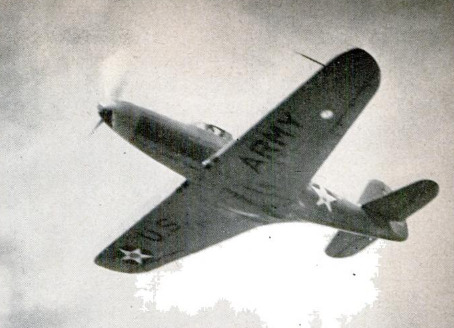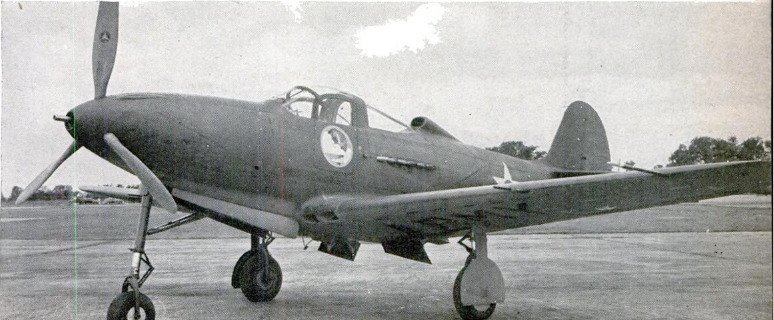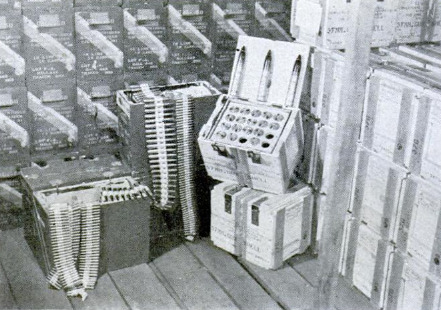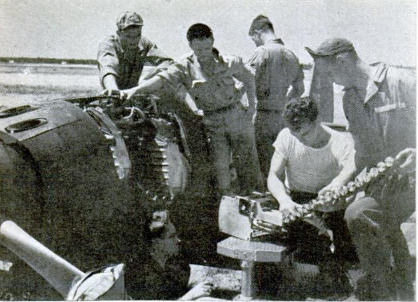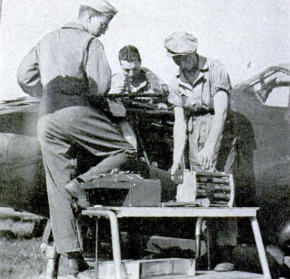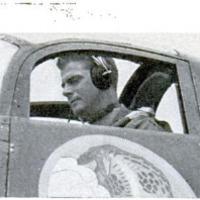World's deadliest flighting ship
Item
-
Title (Dublin Core)
-
World's deadliest flighting ship
-
Article Title and/or Image Caption (Dublin Core)
-
Title: World's deadliest flighting ship
-
extracted text (Extract Text)
-
SEVEN streams of projectiles, one formed
by explosive shells from a 37-millimeter
cannon and six by bullets from four .30 cali
ber and two .50-caliber machine guns, make
the P-39, latest Bell Airacobra of the U. §.
Army Air Corps the most formidable sky
fighter in the world. The cannon, fring
through the nose of the ship, operates auto-
matically as long as the pilot presses the
trigger.
When one of these sleek fighters lifts into
the air and streaks away at a top speed of
better than 400 miles an hour, it carries
three quarters of a ton in guns and ammuni-
tion. In addition, there is a quarter of a ton
of armor plate protecting vital parts. De-
signed primarily for interceptor - fighter
work, the new pursuit ship is the product of
four years of research. The engineers who
worked out the design started with a four-
fold goal: speed sufficient to overtake any
bomber, climbing ability to get above it,
visibility and maneuverability to permit the
pilot to outfight enemy pursuit planes, and
fire power enough to blast
the bomber to pleces once
the interceptor ship dived
on its quarry. Recent tests
made in the north woods of
Michigan by the first squad-
ron of the Air Corps to be
equipped with the new ma-
chines, the 39th Pursuit
Squadron of Selfridge Field,
indicated that all these goals
have been attained.
Main stinger in the Aira-
cobra’s armament is the 37-
millimeter cannon. A direct hit with its ex- |
plosive shells will knock out any bomber
made. These shells are fed into the cannon |
in belts like machine-gun ammunition, dis- |
integrating links of metal holding the shells
together until they are fired. In gunnery |
practice, the Selfridge Field pilots found |
that the recoil of the cannon was noticeable
every time they headed for ground targets
with all guns blazing.
Besides carrying the largest cannon em-
ployed in a fighter plane of
the Air Corps, the new Aira-
cobra embodies a number of
radical departures in design.
The 1,150-horsepower, liq-
uid-cooled Allison engine
is placed amidships, behind
the pilot. It spins the three-
bladed steel propeller by
means of a ten-foot drive-
shaft. Automobile-type
doors increase the ease with
which the pilot can enter
or leave the streamlined
cockpit. Supporting the machine on its land-
ing and take-off runs is a unique tricycle
landing gear which folds into the belly as
the ship rises into the air. The electric mo-
tor which operates the mechanism can re-
tract the landing gear in 18 seconds and ex-
tend it in 12. In the event of failure of this
system, a hand crank installed in the cock-
pit makes it possible for the pilot to ex-
tend or retract the landing gear manually
with little difficulty.
-
Contributor (Dublin Core)
-
John T. Maccoy (Illustrator)
-
Language (Dublin Core)
-
Eng
-
Date Issued (Dublin Core)
-
1941-11
-
pages (Bibliographic Ontology)
-
73-74
-
Rights (Dublin Core)
-
Public domain
-
Archived by (Dublin Core)
-
Sami Akbiyik
 Popular Science Monthly, v. 139, n. 5, 1941
Popular Science Monthly, v. 139, n. 5, 1941

